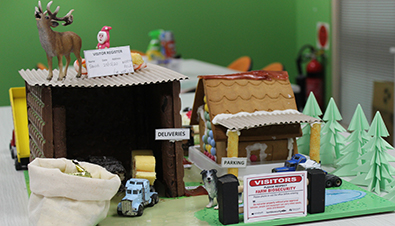Read the latest information on
Foot-and-mouth disease

The winning Farm Biosecurity entry in the Gingerbread House Decorating Fundraiser at Plant Health Australia
As the holidays are now upon us and many of the restrictions imposed due to COVID-19 are lifting, many Australians will be looking to travel to visit family and friends, or simply get out of town.
Animal Health Australia is reminding anyone travelling or expecting guests to be aware of the biosecurity implications that come with travel to our farms, national parks and other regional areas at this time of year. Don’t forget that any movement of people, vehicles and equipment can create new pathways for a biosecurity incursion.
“Farm stays are a great way for property owners to create an additional source of revenue,” says Animal Health Australia’s Biosecurity Coordinator, Bree Beattie.
“Producers should be conscious of the additional external visitors to their property – whether this is farm-stay guests, or even visiting friends or family – and plan accordingly.”
Interacting with livestock and exploring fields, vineyards and orchards can be a big part of the farm stay experience, but it’s important to remember that guests may not be aware of the risks they may pose, even inadvertently.
There are simple measures that property owners can implement to manage the risks that can come from visitors coming into contact with livestock, crops and other production areas. Producers might consider framing these biosecurity measures as ‘part of the experience,’ or using them as an opportunity to educate guests about their practices on-farm.
“COVID-19 has created a newfound awareness and individual ownership of biosecurity practices, and this is a great opportunity to build or consolidate these practices in your biosecurity plan,” Ms Beattie explained.
“Basic hygiene and a visitor register are straightforward measures that you can take to protect your business and clients. Providing clean boots to wear into production zones, providing adequate visitor parking, and fencing off sensitive areas can also help to minimise the chance of an accidental introduction of a disease, pest or weed.”
“There are also significant disease risks associated with grazing livestock and pigs eating meat or other animal products. Take the time to explain to guests that food scraps containing meat or which have been in contact with meat cannot be fed to livestock, and provide a safe way for guests to dispose of food scraps.”
Ms Beattie is also eager to point out that these principles not only hold true on farms, but within all ecosystems. In many instances, such as under New South Wales and Queensland’s respective biosecurity acts, all people have a responsibility to consider the biosecurity risks they pose to the environment.
“Whether it’s around the corner or interstate, we all need to do our bit to protect our industry and environment,” she explained.
“Our native ecosystems can be quite vulnerable to pests and weeds, and wild populations of animals such as feral pigs are a high-risk pathway for the spread of destructive exotic diseases.”
“If I had one key message for travelers this holiday season, it would be to be aware of what impact you’re leaving on the environment as you move about.”
Property owners can find out more about creating or updating a biosecurity plan and implementing biosecurity for people and vehicles on your property on the Farm Biosecurity website. Travellers can find resources on the Australian Government’s Biosecurity portal or by contacting their state or territory government agencies responsible for biosecurity.